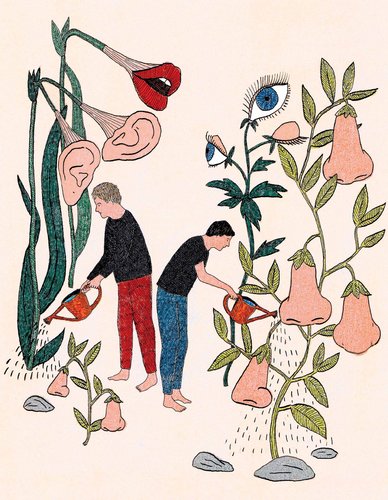FLORENCE, Italy — WE think of our senses as hard-wired gateways to the world. Many years ago the social psychologist Daryl J. Bem described the knowledge we gain from our senses as "zero-order beliefs," so taken for granted that we do not even notice them as beliefs. The sky is blue. The fan hums. Ice is cold. That's the nature of reality, and it seems peculiar that different people with their senses intact would experience it subjectively.
意大利佛羅倫薩——我們把自己的感官想成是通往世界的既定大門。很多年前,社會心理學(xué)家達里爾·J·貝姆(Daryl J. Bem)把我們通過感官獲取的認(rèn)知描述成“零級信念”。它們被如此強烈地視為理所當(dāng)然,以至于根本沒有被我們留意到,這其實是一種信念。天空是藍色的,風(fēng)扇會發(fā)出嗡嗡聲,冰是冷的。這是現(xiàn)實世界的本質(zhì),而感官完好的不同族群會對此有主觀體驗的想法,似乎有些奇怪。
Yet they do. In recent years anthropologists have begun to point out that sensory perception is culturally specific. "Sensory perception," Constance Classen, the author of "The Deepest Sense: A Cultural History of Touch," says, "is a cultural as well as physical act." It's a controversial claim made famous by Marshall McLuhan's insistence that nonliterate societies were governed by spoken words and sound, while literate societies experienced words visually and so were dominated by sight. Few anthropologists would accept that straightforwardly today. But more and more are willing to argue that sensory perception is as much about the cultural training of attention as it is about biological capacity.
然而,人類確實就是這樣。近年來,人類學(xué)家已經(jīng)開始指出,感官知覺和文化有關(guān)。《深層感知:觸摸的文化史》(The Deepest Sense: A Cultural History of Touch)的作者康斯坦斯·克拉森(Constance Classen)說,“感官知覺既是一種生理行為,也是一種文化。”有一個存在爭議的說法因馬歇爾·麥克盧漢(Marshall McLuhan)的堅持而出了名。他堅稱,沒有文字的社會是由口語和聲音主導(dǎo)的,而有文字的社會會用視覺來體驗詞語,因此是由視覺統(tǒng)領(lǐng)的。如今的人類學(xué)家,基本不會簡單地接受這個說法。但他們當(dāng)中越來越多的人愿意提出,感官知覺和注意力的文化訓(xùn)練的關(guān)系,不亞于與生物學(xué)能力的聯(lián)系。

Now they have some quantitative evidence to support the point. Recently, a team of anthropologists and psychologists at the Max Planck Institute for Psycholinguistics and Radboud University, both in Nijmegen, the Netherlands, set out to discover how language and culture affected sensory awareness. Under the leadership of Asifa Majid and Stephen C. Levinson, they made up a kit of systematic stimuli for the traditional five senses: for sight, color chips and geometric forms; for hearing, pitch, amplitude and rhythm variations; for smell, a set of scratch-and-sniff cards; and so forth. They took these kits to over 20 cultural groups around the world. Their results upend some of our basic assumptions.
現(xiàn)在,他們獲得了一些支持這個觀點的量化證據(jù)。近日,一個由人類學(xué)家和心理學(xué)家構(gòu)成的小組開始研究語言和文化對感官意識的影響。這些學(xué)者來自荷蘭奈梅亨的兩所院校:馬克斯·普蘭克心理語言學(xué)研究所(Max Planck Institute for Psycholinguistics)和奈梅亨大學(xué)(Radboud University)。在阿西法·馬吉德(Asifa Majid)和史蒂芬·C·萊文森(Stephen C. Levinson)的帶領(lǐng)下,他們配置了一個工具包,用來系統(tǒng)化地刺激傳統(tǒng)的五感:對視力,使用色卡和幾何形狀;對聽力,使用音調(diào)、振幅和節(jié)奏變化;對嗅覺,使用氣味刮刮卡,諸如此類。他們把這種工具包帶到世界各地的20多個文化群體中進行實驗。研究結(jié)果顛覆了我們的一些基本假設(shè)。
For example, it's fairly common, in scientific literature, to find the view that "humans are astonishingly bad at odor identification and naming," as a recent review of 30 years of experiments concluded. When ordinary people are presented with the smell of ordinary substances (coffee, peanut butter, chocolate), they correctly identify about half of them. That's why we think of scent as a trigger for personal memory — leading to the recall of something specific, particular, uniquely our own.
舉例來說,科學(xué)文獻中有一個相當(dāng)普遍的結(jié)論,借用一篇回顧30年實驗研究的綜述文章中的話來說,那就是“人類極不善于識別和指認(rèn)氣味”。當(dāng)普通人嗅聞到常見物品(咖啡、花生醬、巧克力)的氣味,他們可以正確識別其中大約一半。這就是為什么我們把氣味當(dāng)作個人記憶觸發(fā)器的原因——它能勾起一些具體、特別且個人獨有的回憶。
It turns out that the subjects of those 30 years of experiments were mostly English-speaking. Indeed, English speakers find it easy to identify the common color in milk and jasmine flowers ("white") but not the common scent in, say, bat droppings and the leaf of ginger root. When the research team presented what should have been familiar scents to Americans — cinnamon, turpentine, lemon, rose and so forth — they were terrible at naming them. Americans, they wrote, said things like this when presented with the cinnamon scratch-and-sniff card: "I don't know how to say that, sweet, yeah; I have tasted that gum like Big Red or something tastes like, what do I want to say? I can't get the word. Jesus it's like that gum smell like something like Big Red. Can I say that? O.K. Big Red, Big Red gum."
其實在30年來的這些實驗中,受試者大多都講英語。確實,講英語的人容易識別牛奶和茉莉花均會呈現(xiàn)的顏色(“白色”),但卻很難識別同樣的氣味,比如蝙蝠糞便和姜葉的共有氣味。當(dāng)研究小組使用美國人本應(yīng)熟悉的一些氣味時,比如肉桂、松脂、檸檬和玫瑰等等,卻發(fā)現(xiàn)他們在指認(rèn)這些氣味時表現(xiàn)糟糕。研究者寫道,聞到肉桂味的刮刮卡時,美國人會說:“我不知道怎么講,這個很香甜,恩;我以前吃過這種味道的口香糖,比如大紅牌(Big Red),或者有這個味道的什么東西,我想說什么來著?我想不起那個詞了。天啊,就好像口香糖,有點像大紅牌的。我能那么說嗎?好吧,就是大紅牌,大紅牌口香糖。”
When the research team visited the Jahai, rain-forest foragers on the Malay Peninsula, they found that the Jahai were succinct and more accurate with the scratch-and-sniff cards. In fact, they were about as good at naming what they smelled as what they saw. They do, in fact, have an abstract term for the shared odor in bat droppings and the leaf of ginger root. Abstract odor terms are common among people on the Malay Peninsula.
嘉海人生活在馬來半島的熱帶雨林,以覓食為生。研究小組在他們那里發(fā)現(xiàn),嘉海人對于氣味刮刮卡的回答很簡潔,而且更加準(zhǔn)確。事實上,他們指認(rèn)氣味的能力,不亞于他們指認(rèn)看到的東西的本領(lǐng)。他們還有一個抽象的術(shù)語,用來描述蝙蝠糞便和姜葉同樣的味道。在馬來半島上的族群中,描述氣味的抽象詞語很常見。
The team also found that several communities — speakers of Persian, Turkish and Zapotec — used different metaphors than English and Dutch speakers to describe pitch, or frequency: Sounds were thin or thick rather than high or low. In later work, they demonstrated that the metaphors were powerful enough to disrupt perception. When Dutch speakers heard a tone while being shown a mismatched height bar (e.g., a high tone and a low bar) and were asked to sing the tone, they sang a lower tone. But the perception wasn't influenced when they were shown a thin or thick bar. When Persian speakers heard a tone and were shown a bar of mismatched thickness, however, they misremembered the tone — but not when they were shown a bar mismatched for height.
該研究小組還發(fā)現(xiàn),有幾個社會——使用波斯語、土耳其語和薩波特克語的人——用來描述音調(diào)或聲音頻率的形容詞是粗和細(xì),而不是英語和荷蘭語使用者說的高和低。在后來的實驗中,研究者證明了這些隱喻效力強大,足以影響人們的知覺。當(dāng)荷蘭語使用者聽到一個音,同時看到高度與之不匹配的條塊(例如,聽到一個高音,看到的卻是較低的條塊),然后被要求唱出這個音的時候,從他們口中發(fā)的音調(diào)會比較低。但當(dāng)他們看到粗細(xì)不同的條塊時,知覺不會受到影響。當(dāng)波斯語使用者聽到聲音,并看到粗細(xì)與之不匹配的條塊時,他們就會記錯音調(diào)——但看到高度與之不匹配的條塊時,則不受影響。
The team also found that some of these differences could change over time. They taught the Dutch speakers to think about pitch as thin or thick, and soon these participants, too, found that their memory of a tone was affected by being shown a bar that was too thick or too thin. They found that younger Cantonese speakers had fewer words for tastes and smells than older ones, a shift attributed to rapid socioeconomic development and Western-style schooling.
該小組還發(fā)現(xiàn),其中一些差異可以隨時間改變。他們教荷蘭語使用者把音調(diào)想成粗或細(xì),很快他們就發(fā)現(xiàn),這些受試者對音調(diào)的記憶,也受到了顯示條塊過粗或過細(xì)的影響。他們還發(fā)現(xiàn),在講粵語的人群中,由于社會經(jīng)濟的快速發(fā)展和西式教育的盛行,與年長者相比,年輕人對描述口味和氣味的詞匯量掌握較少。
I wrote this in Florence, Italy, a city famous as a feast for the senses. People say that Florence teaches you to see differently — that as the soft light moves across the ocher buildings, you see colors you never noticed before.
撰寫本文時,我正好在意大利佛羅倫薩。這是一座出了名地提供感官盛宴的城市。有人說,佛羅倫薩教你用不同的眼光看待事物——柔和的光線在赭石建筑物上移動,讓你看到以前從未注意過的顏色。
It taught Kevin Systrom, a co-founder of Instagram, to see differently. He attributes his inspiration to a photography class he took in Florence while at a Stanford study-abroad program about a decade ago. His teacher took away his state-of-the-art camera and insisted he use an old plastic one instead, to change the way he saw. He loved those photos, the vintage feel of them, and the way the buildings looked in the light. He set out to recreate that look in the app he built. And that has changed the way many of us now see as well.
它教會了Instagram的聯(lián)合創(chuàng)始人凱文·斯特羅姆(Kevin Systrom)用別樣的眼光看東西。斯特羅姆說,自己的靈感來自大約10年前通過斯坦福大學(xué)的海外交流計劃在佛羅倫薩參加的一門攝影課程。老師拿走了他的高精尖相機,堅持讓他用一臺老舊的塑料相機,來改變他的觀看方式。他很喜歡這樣拍出來的照片和那種復(fù)古感,以及建筑物在光線中的模樣。他設(shè)法在自己創(chuàng)建的應(yīng)用中重現(xiàn)了那種模樣。于是,這款應(yīng)用也同樣改變了我們很多人的觀看方式。












